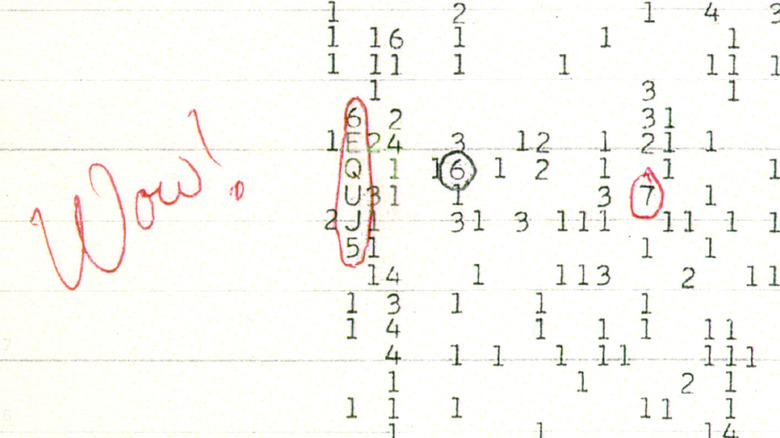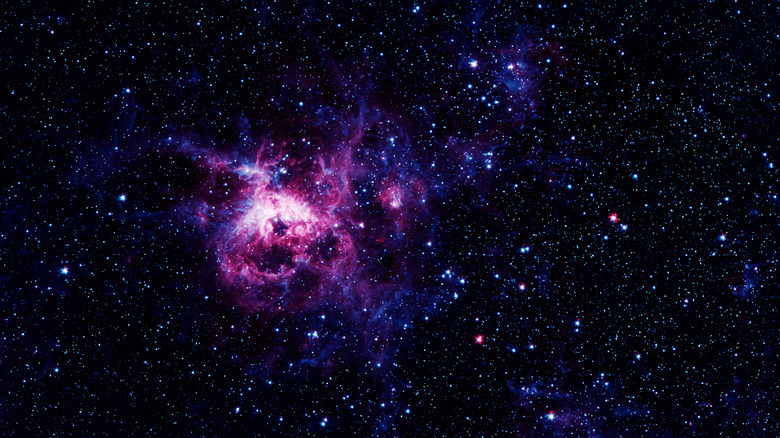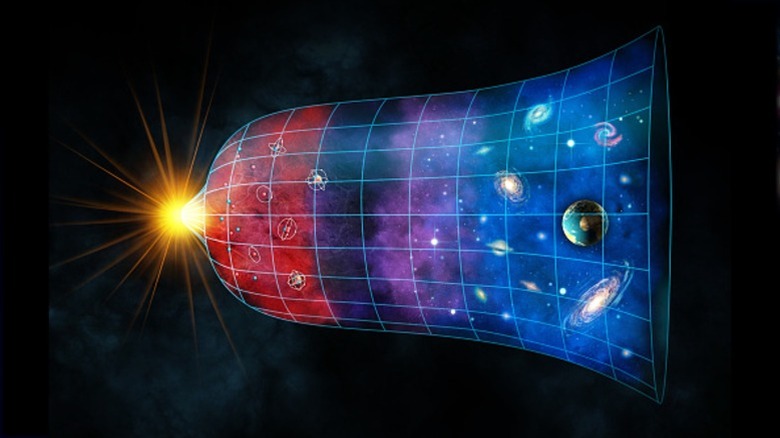8 Biggest Mysteries About Space That Scientists Can't Explain
Space is the final frontier, right? That's what science fiction loves to say, and there's a lot of whimsy and wonder behind such a statement. But that's for a fairly good reason. After all, it's not a controversial stance to think that space is pretty awesome. You don't even need to look far beyond our own little cosmic neighborhood to find some absolutely fascinating stuff; the Curiosity rover has found quite a few cool things on Mars, for example.
But there's also a whole lot happening out in space, and though humanity has spent thousands of years looking into the night sky and trying to piece together exactly what's going on out there, it's no far stretch to say that there's still a lot that we don't really understand, and many mysteries that astronomers and cosmologists can't yet explain. Of course, there are the big, far-reaching questions, tackling things like the Big Bang or the end of the universe, and there are also the ones that could possibly lead to a little bit of existential dread, like theories regarding extraterrestrial life. But even within our own solar system, plenty of mysteries abound surrounding the history of the planets that we consider our closest neighbors.
A long history of studying the cosmos has led to no small number of breakthroughs (NASA even broke quite a few records in 2024 alone), but it's also left scientists scratching their heads at an equal number of confusing questions.
The Oh-My-God Particle
Back in 1991, the University of Utah's Fly Eye detector was monitoring the skies, looking for the sudden appearance of cosmic rays — high-energy, electrically charged particles often thrown into space by energetic events like supernovae. Astronomers happened to observe one such ray flickering brightly in the sky, but when they went to calculate just how powerful that particle was, they found that it packed quite a punch. Not only was it travelling at nearly the speed of light, but it possessed 320 EeV of energy. That's 40 million times more energetic than anything that a particle accelerator has managed to create. Or, to go by a different metric, it's about the amount of energy you'd see in a decent fastball, but packed into the tiny space of a single proton. Scientists had never seen anything like it, fittingly naming it the Oh-My-God Particle.
Over the years, about 100 of these extremely high-energy cosmic rays have been detected around the world. But despite all these detections, scientists still don't know where these particles come from or what gives them so much energy. As far as anyone knows, supernovae aren't able to produce particles with that much energy. Active galactic nuclei (particles created as matter swirls into a black hole) are possible sources, but the distance they'd have to travel would strip them of their speed. What's more, calculations of these particles' trajectories would imply that they're coming from locations in space completely devoid of the high-energy sources required to produce them.
Or, as professor John Belz puts it, "It could be defects in the structure of spacetime, colliding cosmic strings. I mean, I'm just spit-balling crazy ideas that people are coming up with because there's not a conventional explanation" (via Universe Today).
The Fermi Paradox
There's a pretty good chance that at some point, you've wondered if aliens exist. Scientists are far from exempt from wondering the exact same things, and that includes Enrico Fermi. Despite being known mostly for his work on nuclear reactors, the legends say that in 1950, Fermi was discussing extraterrestrial life with his colleagues when he asked where all the aliens were. The conditions for life aren't too uncommon, after all, and there's no reason to think Earth is special, so intelligent life should exist somewhere out in the cosmos. Yet, as far as we can tell, no such life exists.
That question has since become known as the Fermi Paradox, and despite researchers looking far and wide for signs of life, no one has been able to answer Fermi's question. And it's not for lack of trying. Scientists are constantly on the lookout for exoplanets with conditions favorable to the development of life. They've even found many planets that might fit the bill; to name one, exoplanet K2-18b was found to contain a gas produced by simple marine organisms here on Earth. Then, there's the question of life on Mars; an unassuming rock proved that Mars once had water, a potential indicator of past life, and there are even theories that a NASA experiment actually destroyed traces of Martian life.
Or, if you like math, there's the Drake Equation, a way to calculate the number of technologically advanced civilizations in the Milky Way. The original equation comes with plenty of unknowns that make calculations difficult, but later simplifications have gone on to imply that it's incredibly unlikely that Earth is the only planet to have ever given birth to an advanced civilization. So, in that case, where are all the aliens? Maybe we'll never know.
The Wow! Signal
When it comes to discussions of extraterrestrial life, the Wow! Signal is a pretty famous topic. In 1977, Ohio State University's Big Ear radio telescope picked up a peculiar signal coming from deep space. The 72-second-long signal was strange for its incredible intensity and highly specific frequency. When astronomer Jerry Ehman took a look at the data the following morning, he was shocked by the transmission, famously circling the string of letters and numbers that represented it and writing "Wow!" in the margins. But when Ehman and his associates searched for the signal again, they found nothing.
The signal's unusual nature has led many to believe that it wasn't a naturally occurring phenomenon; in other words, people thought that aliens were sending us a message. But scientists have also searched for explanations aside from extraterrestrial life. In 2016, one theory raised the idea that the signal was caused by a then-unknown comet passing through the area. Ehman himself has also weighed in, saying that the telescope might have picked up the end of a fast radio burst, an astronomical phenomenon that itself has unknown origins.
More recent research has found similar (but weaker) signals picked up over the years, and that those signals line up with the location of cold hydrogen clouds. Those clouds could hypothetically emit signals like the Wow! Signal, provided they were hit with a huge wave of energy. Scientists have proposed that a magnetar — a spinning neutron star — might have let out a violent blast of microwave energy that magnified the natural emissions of a hydrogen cloud. It's a definite possibility, but not everyone is convinced, with some arguing that such a phenomenon might not even be possible. So for now, the origins of the Wow! Signal are still a mystery.
The history of Venus
It's not uncommon for Venus to be referred to as Earth's twin when it comes to mass and size, and the planet inhabits an orbit relatively similar to that of our own planet. But when you look beyond those superficial similarities, Venus is a very different, very hostile place. Despite being the second planet from the sun, it's the hottest planet in the solar system with surface temperatures high enough to melt lead, and it hosts a thick atmosphere of corrosive acid
And yet, scientists think that Venus could have once supported life. For the first 2 or 3 billion years of its existence, Venus might have actually had liquid water on its surface and surprisingly pleasant global temperatures ranging from 68 to 122 degrees Fahrenheit. Had it remained that way, there might even be life on the planet today. But 700 million years ago, something changed, eventually leading to the runaway greenhouse effect seen in the present day.
What was that change? That's the real question. Some theories look to the fact that Venus receives twice as much solar radiation as Earth does, explaining that the additional heat evaporated much of the planet's water; that additional water vapor in turn trapped even more heat, causing more evaporation, until any liquid water was completely gone. But other simulations have implied that, despite the increased radiation, Venus should have still had a stable climate capable of supporting liquid water. Instead, some sort of resurfacing event might have released tons of carbon dioxide from the planet's rocky surface that couldn't be reabsorbed, snowballing into the present-day greenhouse effect. The exact nature of that resurfacing event is still debated, though; volcanic activity might have been to blame, but more research is needed to come to a solid conclusion.
The nature of dark matter
Back in the 1930s, astronomer Fritz Zwicky stumbled upon something pretty strange. While observing the Coma galaxy cluster, he noticed that the galaxies were moving really fast — too fast, actually. Without getting fully into the math, the speed of galaxies in a cluster should be dependent on the size and mass within that cluster. But in this case, the math wasn't lining up; for the galaxies to be moving at the velocity that they were, there had to be more mass than Zwicky was seeing. Four decades later, another astronomer, Vera Rubin, discovered a very similar discrepancy while looking at the rotation of individual galaxies, seemingly confirming the existence of some kind of invisible matter — something that affected space gravitationally, but didn't interact with light — which was shortly coined "dark matter."
Proportionally, dark matter makes up about 27% of the known universe (for reference, the visible matter we're familiar with only makes up a meager 5%), and it probably isn't a variant of any kind of known matter. Rather, it seems to exist in a web that stretches across the universe, providing a structure that attracts clumps of visible matter, forming something like a halo around the stars and galaxies that form.
But anything beyond that lives only in the realm of speculation. Some scientists have proposed that there isn't any new matter, and we've just misunderstood the rules of gravity. Others have posited that it's some exotic material that just doesn't interact with visible matter, perhaps because it's too light and fast. Still others have even theorized that dark matter is actually tiny black holes, which are inherently hard to observe but also incredibly massive — an explanation that works in principle but is also hard to prove.
Dark energy and the expansion of the universe
We're all familiar with gravity — that force that keeps your feet firmly planted on the ground. More generally speaking, it's also a force that pulls all objects toward each other. But if all matter should be pulling toward each other, why is it that the universe is actually expanding? And not only that, why does the rate of expansion keep increasing?
Since the time of Albert Einstein, scientists have pondered this question — and the existence of some sort of anti gravitational force — and they haven't found a good answer. But they did give it a name: dark energy. In short, dark energy accounts for a majority of our universe's composition (about 70%, in fact), it's responsible for the accelerating expansion of the universe, and it seems to be relatively uniform wherever we look. But the mechanism behind those effects is still unknown. A popular theory, called the cosmological constant or vacuum energy theory, proposes that the vacuum of space itself somehow creates the force that we know as dark energy. Or there's the quintessence theory, which proposes that dark energy functions like a magnetic field, able to affect the entire universe but also capable of fluctuations and changes over time.
Then, there's a newer theory on the block, known as Timescape, which claims that dark energy might not exist at all. The theory hinges on the fact that gravity alters the flow of time — more gravity means that time flows more slowly. So in large voids in space, time flows faster than it does in the star-filled Milky Way, meaning it's had relatively more time to expand. From our viewpoint, it would look like the universe's expansion is accelerating, when in reality, it's actually just a problem of perspective.
The Fermi Bubbles
In 2010, scientists working with data from NASA's Fermi Gamma-ray Space Telescope happened to stumble upon something quite strange: two bizarre bubbles that were sandwiching the Milky Way galaxy. Each of those bubbles — fittingly named the Fermi Bubbles — stretch 25,000 light years away from the center of our galaxy and have incredibly well-defined borders, emitting distinctive, high-energy gamma rays. The bubbles stretch across much of the visible sky, but how they got there — and how they work — are still a mystery.
The best guess is that the bubbles are somehow tied to Sagittarius A*, the supermassive black hole at the center of the Milky Way. They could be like the jets of particles expelled by other black holes, even though there's no evidence that Sagittarius A* currently has any such jets. Rather, the bubbles could be the remnants of matter that was sucked close to the black hole and energized to extreme levels eventually dispersing into the current, bubbly shape. Or, to go another route, the bubbles could have come from massive outbursts tied to the many stars near the Milky Way's center; star formation can lead to outbursts of energized particles, as can supernovae.
But the mysteries go beyond the origins of the Fermi Bubbles, because no one really knows how they work, either. Scientists know that they produce gamma rays, but the bubbles also seem to produce neutrinos — tiny, nearly massless exotic particles that don't really interact with normal matter. There's the possibility that one process might be responsible for both of those effects, but there's no confirmation. For that matter, scientists can only guess what that process involves. Other exotic particles? Magnetic fields? The cosmic microwave background? No theory has really fit all the data.
The end of the universe
A lot of questions about space and the universe require looking backwards in time, trying to figure out why things are the way they are. But what if we were to look forward in time? How is everything going to end?
Cosmologists continue to debate this, and there are a lot of theories that fly around. One of the earlier theories is known as the Big Crunch theory, which stated that there was enough matter in the universe for gravity to eventually overcome expansion. The universe would then shrink back in on itself and end in, well, a really big crunch as all matter fell back into an infinitely small space. From there, some scientists hypothesized that a new Big Bang would take place, creating a new universe — a potentially cyclical, repetitive sequence of events referred to as the Big Bounce. But with the later discovery that the universe seemed to be expanding faster than ever, a new theory came into the spotlight: the Big Freeze (or its variant, the Long Freeze). This school of thought revolves around the eventual heat death of the universe. Matter and energy would be spread so thin that the overall temperature of the universe would barely exceed absolute zero, no new stars would form while old ones fell apart, and eventually, only black holes would be left (though they would also sputter out over time). Or, most devastating (though also most unlikely), is the Big Rip, in which the expansive force of dark energy literally tears everything — from galaxies to individual atoms — apart.
None of those theories sound especially great, and not knowing which, if any of them, are accurate, certainly doesn't help. At least we have a long time before needing to ever worry about it.








